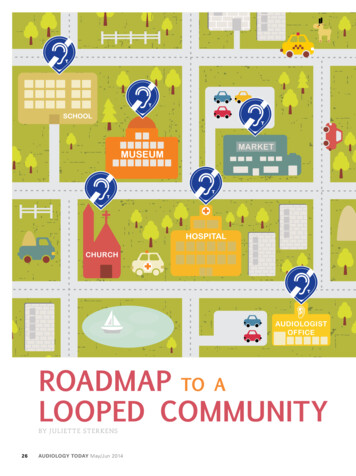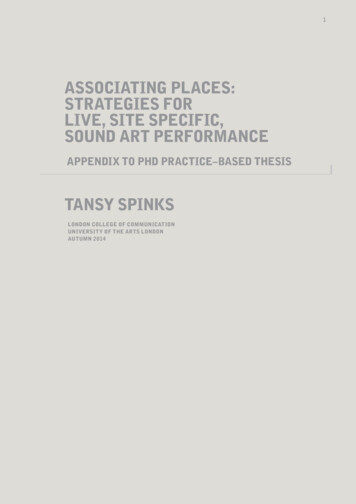
Transcription
MARKETCHURCHAUDIOLOGISTOFFICEROADMAP TO ALOOPED COMMUNITYBY JULIET TE STER KENS26AUDIOLOGY TODAY May/Jun 2014
If all audiologists would foster one ortwo loop installations, we could makethis technology universally known as thewheelchair ramps for hearing aid users.By being an advocate for your clients,you will be known in your community,not only as an expert provider of hearingcare but also as one who promotes andadvocates for better living.an audiologist in private practice, Ihave helped my clients navigate the different hearing aid technologies on the market.Hearing aids have made improvementsin the last 10 years that resulted in betterfeedback suppression, improved speechunderstanding in quiet, reduced occlusion, and a reduction in loud backgroundnoise complaints. This made it excitingto work in my chosen field. Yet even withthe best and most advanced technology,patients continued to complain about theirinability to hear in many public places.After spending time with several clients,many of whom became dear friends afterseeing them professionally for some 25years, I observed their struggles firsthand. Particularly in situations where myclients wanted to hear their best (housesof worship, high school theaters, and largemeeting rooms) the hearing aids I so carefully fit were unable to deliver.Wireless hearing aid systems, designedto be used at home with TV and cell phonesignals, made a difference for only a few ofmy clients. While the streamer and clipon mic looked cool and neat in the office,many of my clients did not take to usingthem on a daily basis. Streamers, I found,could be “temperamental” and sometimeswould cut off the Bluetooth signals fromcell phones for no apparent reason, andlinking to computers was even trickier.Sure, my patients sat patiently in my officewhile I tried to reboot, link, and pair thedevices with cell phones. They appreciatedthat I called the hearing aid manufacturers’tech support, but it did not allay their fearsthat they could handle this technology athome. And too many of them walked backinto my office only a few weeks later withthe wireless peripherals in a bag, apologetically explaining, “I tried it, doc, but they aretoo much hassle” or “I could not get them towork at home.”I am convinced that I am not the onlyaudiologist to have experienced problemswith these advanced devices. An audiologist in a large multilocation private practicetold me, “I have a drawer full of clip-onmics, as they come included with many ofour orders, but I cannot give them away.”A sales representative from one of thelarger hearing aid manufacturers told methat in his territory, only between 10 and15 percent of all wireless hearing aids areordered with the wireless devices such asclip-on mics and TV devices. If clients areMay/Jun 2014 AUDIOLOGY TODAY27
Roadmap to a Looped Communit ynot using these devices, we cannot help them in the situations they came to see us for in the first place.A Solution for the NontechnicalThere is a solution for places where hearing aids do notwork. This solution is a system that does not requirelinking, pairing, charging, or the use of a peripheraldevice. This solution is a system that makes clients opento exploring other assistive technologies and will helpset realistic expectations, and has motivated clients tospeak up for themselves. Hearing loops are this system.Hearing loops are able to help our clients hear better insome venues than their normal hearing spouses besidethem. This system is easy to use and does not consumebattery power. This can come through the touch of abutton, through hearing aids they are already wearing intheir ears, provided you had the foresight to fit them withtelecoils in the first place.Why Hearing Loops WorkTo fully understand why our clients respond positively tohearing loops, it is important to understand what a loopdoes for them. The hearing loop transforms the microphone that is used on the lectern, or the pulpit, or worn onthe ear of an actor on stage directly into the microphoneof the hearing aid. It is as if the user has his or her ear justinches away from the mouth of the speaker. The resultis a dramatic improvement in signal-to-noise ratio onthe order of 15–25 dB, an improvement that can never beobtained with hearing aids alone. Even the most advancedhearing aids improve SNR less than 3–5 dB in the realworld and not the effortless listening our clients crave.Hearing in a hearing loop exceeds user expectations,and this makes our clients happy, very happy. Imaginesitting in your office talking to an enthusiastic clientwho just cannot get over how well his telecoil-equippedhearing aid was able make him hear in a looped theater,lecture room, or church service? Read more to learn howyou can help get your community in the loop.Loop Your OfficeLooping a waiting room or a patient room can usually beaccomplished in an hour or two, and several Web sitesgive details how to install the wire or seat cushion loopto a computer or TV (www.hearinglosshelp.com). Invitea local hearing loop installer to verify the field strengthof the loop, that way you can be certain that the telecoilsset properly. Request that the manufacturers provide youwith the SPLIV telecoil test results. A SPLIV telecoil testlets you see at a glance if the microphone and telecoil settings match and whether the telecoil is vertically oriented.28AUDIOLOGY TODAY May/Jun 2014Several Web sites offer great step-by-step directionson how to connect a TV or computer to a loop. A TV loopdriver with a volume control is recommended. This allowsthe audiologist or front staff to quickly demonstrate TVloop “on” versus “off” in a waiting room when the hearingaid is set to M T. These demonstrations are fun and oftenget other clients in the waiting room talking and interested in looping. Many of my clients’ out-of-town familymembers have taken materials home to share with ministers in their hometowns. This is where advocating for allpeople with hearing loss begins.Once your clients have experienced a loop in yourwaiting room and your community has facilities withhearing loops such as houses of worship or meetingrooms you will want to send them to try out the loop. Besure to personally verify with a programmed hearing aidthat the loops in these locations are working well beforesending clients to try it out.Educational materials that help explain hearing loopscan be found on the Academy’s Web site under the “Getin the Loop Campaign” (www.audiology.org/resources/consumer/pages/get in thehearingloop.aspx). Place hearing loop information in your waiting room or set up a TVloop in your waiting room, so your patients can experience the system while they wait for their appointments.Educate Your CommunityHearing loops help increase awareness of the needs ofpeople with hearing loss. By explaining to our patientswhat hearing loss is and the limitations of hearing aids,especially in reverberant and large, noisy environments,we can demonstrate how hearing loops can provide seamless access in these situations. You can also offer to give a“Get in the Loop” lecture to service clubs, local HLAA chapters, or a senior center. If you are lucky to have a Sertoma(SERvice TO MAnkind) club in your area, you will find thatthey are very interested in this message. Sertoma recentlystarted the Sound Investment Campaign, which focuseson improved access for the hard of hearing in the communities they serve.Hearing aids help much like wheelchair ramps do forpeople with mobility handicaps. Using this mindset, it iseasy to build the case and get support for hearing loops.PowerPoint presentations on looping are available on theAcademy’s Web site or by e-mailing the author. A shortnewspaper article or a letter to the editor explaining howyou and your practice want to bring the community “inthe loop” can be very effective. Mary Caccavo, PhD, audiologist in Lafayette, IN, commented that she has beeninvited to speak at service clubs and regional professionalconferences on the topic of looping. Dr. Caccavo says this
Roadmap to a Looped Communit yis “a visibility I would not have had if not for the simpletruth of having something of importance to say.”Financing of the hearing loops often comes fromgenerous donations from the local community. A coupleof years ago I gave a lunch presentation at local Rotaryclub. Afterwards someone came up to me and offered to,anonymously, donate the funds to fund a loop installationat a local theater that happened to be undergoing renovations at that time. I danced all the way back to officeafter that lunch meeting knowing that my patients wouldbenefit. Other loops were financed with CommunityFoundation donations, or by clients who wanted to giveback to their local church or favorite charity. One olderclient, sadly, did not live to see her fondest wish to havea loop installed in her church come to fruition. Thanks tomy client’s children, her memorial funds were given tothe church and earmarked “Hearing Loop Fund.” A yearlater, the loop was installed much to the delight of manyhard-of-hearing members.Many installers willprovide advocacy materialsfor your office and mayinvite you to speak asthe local professional atloop commissioning ordedication events.Foster InstallationBy actively being involved in the successful installationand promotion of a hearing loop in a large facility, youAudiologyhttp://www.auAudiologySolutions NetwdiologysolutioorkSolutions Networknsnetwork.orgVisit the industry’s most dynamicresource directory! Explore profiles,videos, social media, live events, andmuch more from the leading suppliersin the audiology un 2014 AUDIOLOGY TODAY29
Roadmap to a Looped Communit ywill be seen as a community-minded audiologist andthe go-to person for questions regarding hearing access.Many success stories about audiologists who have donejust that can be found on the Internet. Several audiologists have fostered a relationship with local installersto loop their community. Whether you are advocatingon behalf of your clients or are considering a monetarydonation to loop a particular venue as part of yourmarketing budget, be sure to visit several of the loopinstaller’s jobs and listen with a telecoil-equipped hearing aid for yourself. You will find that the time you havespent sorting out a good hearing-loop installer from lesscapable ones is time well spent. Vendors should offerinformation on their Web sites regarding recent loopinstallations and be willing to give you references of pastinstallations. To find a list of hearing loop vendors bystate visit www.hearingloop.org/vendors.html.Some audio engineers are new to hearing loop technology. This need not be a detriment. With technical designsupport from their suppliers they can quickly get upto speed on installation techniques. The InternationalElectrotechnical Commission (IEC 60118-4) standardensures that hearing loops are properly configured andwork well with the hearing instruments. They make surespillover, interference with other electronic equipment,and head tilt are all considered. This will provide yourclients with clear, strong signals wherever they sit.Are some loop installations more difficult and costlyto complete than others? The answer is yes. Some loopinstallations, notably the phased array loops can cost twoor three times more than a conventional perimeter loop.It takes an ethical installer, who, sensitive to the ultimateend users—our clients—and concerned about maintaining the reputation of hearing loops, will refuse to installa loop that he or she knows will not meet the standard oris beyond his or her capabilities. Insist that the hearingAUDIOLOGISTOFFICE30CHURCHAUDIOLOGY TODAY May/Jun 2014loops you commission or help fund as part of your marketing strategy, meet this standard. A handout on howto purchase a hearing loop and how you can verify itsperformance can be found here: any local installers are willing to work closely withhearing-care providers by providing generic advocacymaterials to hand out in your office, and may invite youto speak as the local professional at hearing loop commissioning or dedication events. Hearing-loop installers,who are not familiar with hearing aids, will defer to youfor hearing aid questions or invite you to listen to thehearing-loop performance. Installers have been knownto install a temporary hearing loop for consumer loopingseminars knowing that such an event often leads to moreinstallations. This is good for all involved.Make Sure the Loop Is Working WellThis is easy. Always carry a hearing aid with a telecoilwherever you go. It allows you to listen to what it soundslike if you were using the hearing aid in the acousticmode versus the T or M T setting. It also gives you theexperience to give advice to sound board technicians ortheater operators regarding the working of the loop. Aswith all assistive listening technology, be it FM, Infrared,or inductive, if the signal feeding it is of poor quality(e.g., noisy, reverberant, distorted, and muffled), then thesound that a user of the system hears will also be of poorquality. I speak up for my clients. I believe that the sorrystate of many ALS systems in this country is becausewe have dropped the ball and have failed to be strongadvocates for better assistive hearing systems on behalfof our clients.A couple of years ago I took my mother, who useshearing instruments, to a Thanksgiving prayer serviceat a recently looped local theater. When I sat down I was
Roadmap to a Looped Communit ygreeted by at least a half dozen clients in the seats aroundme. Some waved and some pointed to their hearing aidsand smiled when I motioned and nodded to their querying faces that, yes, the loop would be working. I put in myown hearing aid as well just before the service started,only to find out, much to my dismay, that the sound fromthe mics on stage was not being routed through the loop. Iwas not the only who noticed; my mom was disappointedabout her first use of a public loop, as were the half dozenclients who were in the theater with me. I took the timeto send a letter to the manager of the theater explainingmy mother’s and my clients’ disappointment. A changein procedures at the theater meant that the loop at thisyear’s Thanksgiving event worked flawlessly.If all audiologists would foster one or two loop installations, we could make this technology universally knownas the wheelchair ramps for hearing aid users. By beingan advocate for your clients, you will be known in yourcommunity not only as an expert provider of hearing carebut also as one who promotes and advocates for betterliving. Choose a house of worship or a public venue yourclients frequent and get started! Hearing loops begethearing loops. Our collective effort to make assistive listening directly hearing-aid compatible will lead to greaterincreased consumer satisfaction with hearing instruments and show we truly care for America’s hearing.Recent Grads!Take the next step,become a FellowMemberThe Academy is invested inhelping the future of audiologyand wants to offer youdiscounted Fellow membershipdues for the first two yearsfollowing your graduation.To learn more, visit www.audiology.org.Search key word UPGRADE.Juliette P.M. Sterkens, AuD, is a HLAA member and hearingloop advocate. Thanks to a grant from the Carol and DavidMyers Family Foundation, the writer of this article is currentlyon a sabbatical from her audiology practice to advocate for theinstallation of hearing loops on behalf of all people with hearingloss. She welcomes invitations to speak at state conferences andAuD programs. Her involvement has led to over 300 hearingloop installations in Wisconsin and many more beyond the stateborders. Dr. Sterkens can be reached at jsterkens@new.rr.com.MARKETMay/Jun 2014 AUDIOLOGY TODAY31
Hearing loops help increase awareness of the needs of people with hearing loss. By explaining to our patients what hearing loss is and the limitations of hearing aids, especially in reverberant and large, noisy environments, we can demonstrate how hearing loops can provide seam-less










